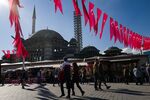Turkey’s War Against the Markets
What You Need To Know
From state institutions to the media, President Recep Tayyip Erdogan tightened his grip on just about everything in Turkey since a failed coup against him in 2016. The one force he couldn’t seem to rein in was the free market.
For a time, Erdogan got what he wanted: lower borrowing costs and a drop in inflation. But the economic toll mounted. The central bank used up its dollar reserves, inflation climbed, and foreign investors became more reticent to commit money to the country, abandoning the Turkish lira in droves.
What was once one of the most traded currencies in emerging markets is now overlooked by many global funds. And by removing his third central bank governor in less than two years, Turkey’s strongman demonstrated again his determination to fight the conventions of modern economics.
Thinner Buffer
Turkey's currency reserves fell steeply in 2020
Source: Central Bank of the Republic of Turkey, Bloomberg
Note: Borrowed money is defined as the central bank's monthly outstanding swap stock through September
There’s constant speculation in the markets that Erdogan could go further and impose some form of capital controls to stop money leaving the country. It’s something the government has denied, and it has repeatedly pledged commitment to free market principles and a liberal currency regime.
Turkey already made it difficult for money managers based overseas to freely exchange the lira. In an effort to control the currency without raising interest rates over the past two years, the government imposed limits on swaps with foreign investors while state lenders flooded the market with dollars, drawing down on the central bank’s reserves.
That also raised the prospect that Turkey will have to seek financial assistance from the International Monetary Fund to shore up its foreign currency reserves.
Wary of Lira
Turkish savers show little sign of abandoning dollars and gold
Source: Central Bank of the Republic of Turkey
Key Coverage
By The Numbers
- >$100 billion What Goldman Sachs estimates the central bank has used of its foreign-currency reserves to support the lira.
- 18% Gain in the lira against the dollar during former central bank chief Naci Agbal’s tenure.
- $4.7 billion Net flow into stocks and bonds in the months following Agbal’s appointment in November.
Why It Matters
Erdogan’s unexpected dismissal of central bank Governor Naci Agbal on March 19 hit investor confidence just as it had begun to return. During the four months he was in the job, Agbal had overseen a strong rebound in the lira after raising interest rates by 875 basis points. He was ultimately fired for going against Erdogan’s contested view that higher rates fuel inflation.
His replacement, Sahap Kavcioglu, is a former lawmaker from Erdogan’s Justice and Development party and has in the past echoed similar views to the president’s on borrowing costs, leaving investors uneasy about the policies he might pursue. Erdogan’s drive for lower rates to fuel economic growth left the lira exposed to cycles of sell-offs in the past.
While the Turkish president was looking at a year of strong growth and a stable lira, his actions over a weekend in March have made Turkey a tougher sell to foreign investors. The abrupt move at the central bank wrong-footed lira bulls.
The coronavirus pandemic gives Turkey’s president a face-saving way to ask for help.




















